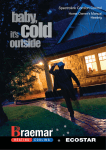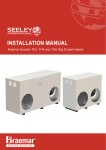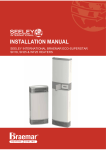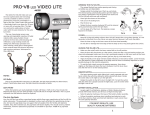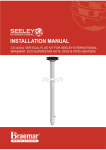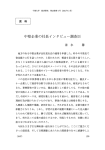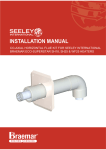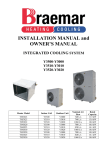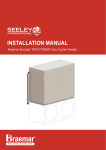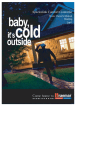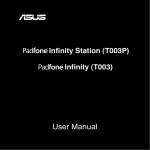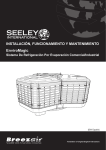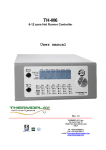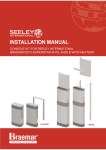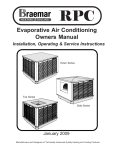Download INSTALLATION MANUAL
Transcript
INSTALLATION MANUAL Braemar Ecostar THM5, THM6 and TSS6 Gas Ducted Heater THIS HEATER IS TO BE INSTALLED BY AN AUTHORISED PERSON ONLY DO NOT DO NOT DO NOT DO NOT DO NOT Operate this appliance before reading the instruction booklet. Place articles on or against this appliance. Use or store flammable materials near this appliance. Operate this appliance with panels, covers or guards removed. Spray aerosols in the vicinity of this appliance while it is in operation. This Braemar gas ducted heater must be installed in accordance with these instructions, local gas fitting regulations, municipal building codes, electrical wiring regulations, Australian Standard AS/NZS 5601 Gas Installations and any other relevant statutory requirements. This heater must not be installed downstream from an evaporative cooler, air washer or indoor unit of a refrigerated system. This heater is not suitable for installation in a marine environment. For external installations, ensure that the heater is located to maintain the minimum flue clearances as specified below and in AS/NZS 5601. Measurement is taken from the edges of the flue terminal. GAS TYPE: GAS CONSUMPTION: Refer label alongside gas inlet. Refer data label on underside of appliance lid. UNPACKING THE HEATER Remove the plastic wrap and cardboard transport cover. Check that the heater model and gas type is as required - model details are provided on the specification label on the end panel of the heater, gas type is given on the label next to the gas inlet. Report any transit damage within 7 days - Do not install the heater if it is damaged. SAFETY INSTRUCTIONS Employers and Employees Responsibility The installation and maintenance of gas ducted heating units, particularly at height, has the potential to create Occupational Health and Safety issues for those involved. Installers are advised to ensure they are familiar with relevant State and Federal legislation, such as Acts, Regulations, approved Codes of Practice and Australian Standards, which offer practical guidance on these health and safety issues. Compliance with these regulations will require appropriate work practices, equipment, training and qualification of workers. Seeley International provides the following information as a guide to contractors and employees to assist in minimising risk. Risk Assessment Some points to consider Some points to consider when working on or in a roof What is the best and safest access to the roof and working areas? What condition is the roof in? Should the roof structure and surface be checked? Does the worker have appropriate footwear? Are all power cables/extension leads safe and appropriately rated? Are all ladders, tools and equipment suitable and in good condition? Where ladders are to be used, is there a firm, stable base for A risk assessment of all hazardous tasks is required under legislation. A risk assessment is an essential element that should be conducted before the commencement of work, to identify and eliminate the risk of falls and other risks, or to minimise these risks by implementing control measures. This does not need to be a complicated process - it is a matter of assessing the job to be done and considering what actions are necessary so the person doing the job does not injure themselves. This should be considered in terms of: What are the chances of an incident occurring? What could the possible consequences be? What can be done to reduce, or better still, eliminate the risk? them to stand on? Can they be tied or secured in some way at the top? Is there a roof anchor to attach a harness and lanyard to? If so, instruction should be issued for the use of an approved harness or only suitably trained people used. Are all tools and materials being used, prevented from slipping and falling onto a person at ground level? Is the area below the work area suitably protected to prevent people entering this area? Does the work schedule take into account weather conditions, allowing for work to be suspended in high winds, thunder storms/lightning or other types of weather giving wet, slippery surfaces? Is there an on-going safety check system of harnesses, ropes, ladders and access/lifting equipment, and any anchor points on roofs before the commencement of work? Is there a system which prevents employees from working on or in roofs if they are unwell or under the influence of drugs or alcohol? Are there any special conditions to consider i.e. excessive roof pitch, limited ground area, fragile roof,electrical power lines? HEATER LOCATION Avoid quiet areas: Directly above, below or outside bedrooms, living room, lounge room, dining room etc. 1 THM5, THM6, TSS6 Preferred installation locations Above, below or outside laundry, bathroom, kitchen, garage etc’ HEATER CONFIGURATION Standard External Configuration Swapping inlet & outlet panels The heater side panels can be moved to suit a range of installations. To do this: Remove heater top panel. Remove the screws securing the side/end panels that are to be changed. Remove the side panels. Move the inner metal insulation panel to the side or end of the heater to ensure a twin skin sheetmetal layer is maintained. Secure the side panels in their required new positions and re-fit the heater lid. Check that all panels are secure and that screws are tight. IMPORTANT: Increase the diameter of the air inlet spigot and the full run of inlet duct by 50mm to maintain the original air flow rate if it is moved from the open side to the motor side of the room fan. IMPORTANT: The air inlet panel must be fitted to the side of the heater - do not fit the air inlet panel to the end of the heater. SPLITTING AND RE-CONNECTING THE HEATER All THM/TSS series heaters can be split in two (remove fan box) to assist in lifting heaters into ceilings and moving the heater into position: Reversed External Configuration Increase inlet spigot and duct diameter by 50mm Optional Internal Configuration WIRING LOOM PLUG & SOCKET COMBUSTION FAN SUCTION HOSE ROOM FAN END OF HEATER HEAT EXCHANGER END OF HEATER Splitting the heater Remove the heater top panel. Disconnect the wiring loom at the plug near the top of the centre panels. Disconnect the combustion fan suction hose from the pressure switch connector. Disconnect the ignition lead and the white flame sense lead from the Fenwal ignition pack and feed through the grommet in the centre panel. Remove the two retaining screws near the top of the centre panels from the room fan end of the heater. Lift the room fan end of the heater to disengage from the locating tabs near the bottom of the centre panel. Separate the two halves of the heater. PRESSURE SWITCH SUCTION CONNECTIONS 2 LOWER CONNECTIONS RETAINING SCREWS ROOM FAN END OF HEATER HEAT EXCHANGER END OF HEATER LOCATING TABS Re-connecting the heater Hook locating tabs into slots near bottom of centre panel. Re-fit 2 retaining screws near top of centre panel. Re-connect the combustion fan suction hose onto the pressure switch suction connector. Re-connect wiring loom plug into socket. Re-connect the ignition lead and flame sense lead to Fenwal ignition pack. Re-fit heater top panel. RE-FIT 2 RETAINING SCREWS HOOK LOCATING TABS INTO SLOTS ENSURE TABS ARE LOCATED IN SLOTS AT BOTH SIDES TEST THE HEATER ONCE RE-CONNECTION HAS BEEN COMPLETED SEELEY INTERNATIONAL – INSTALLATION MANUAL 2 Reversing combustion flue outlet THM5 1. Remove side panels from combustion fan end of heater. Reversing combustion flue outlet THM6, TSS6 1. Disconnect flue fan extension from combustion fan. Remove flue outlet cover from opposite side of heater. 2. Twist combustion fan towards burners, lift fan up to separate from heater. 2. Twist combustion fan towards burners, lift fan up to seperate from heater. 3. Turn combustion fan 180 degrees. locate fan feet in 4 round holes in flue pan twisting combustion fan towards burners to lock. 3. Turn combustion fan 180 degrees. locate fan feet in 4 round holes in flue pan twisting combustion fan towards burners to lock. 4. Fit side panels back to heater. 4. Reconnect flue fan extension using silicon to seal connection. Secure flue outlet to side panel using screws previously removed. Fit flue outlet cover to the original outlet hole. Heater ADD-ON REFRIGERATED COOLING TH Extra Air heaters are designed for use with an add-on refrigerated cooling system - these models include an “X” in their model numbers, eg, THM5X20, THM6X32 and TSS6X23. The following points must be taken into account to ensure correct operation of both the refrigerated cooler and the heater. 3m Ensure that the refrigerated cooling unit is sized correctly to suit 1.5 to 2.5 m Supply air Return air duct the house and the heater. duct The cooling coil (evaporator) should be installed 1.5 to 2.5m from the heater supply air outlet. To prevent excessive air flow restriction, the ducting between the Cooling coil heater and the cooling coil should be as straight as possible. If Duct thermistor bends are required, use the largest bend radius possible. mounted in duct AFTER cooling coil A correctly-sized return air grille with a filter MUST be fitted when installing add-on refrigerated cooling. The thermistor must be located after the cooling coil 3m along the EVAPORATIVE AIR-CONDITIONER CONNECTION duct from the heater outlet, and fitted centrally in the top of the A Seeley International evaporative air-conditioner equipped with duct. a CPMD controller can be operated from a Braemar SCC The “A/C” terminals on the BSC coircuit board in the heater supply thermostat. 24Vac control voltage to operate the cooling system. The preferred Connect as shown. connection from the heater is via a 24Vac relay to switch the cooling system on and off - this is not supplied by Braemar. MCB AUTO ON HEAT Ensure that “COOL 2” is selected during system set-up to enable the system to operate the regfrigerated cooling system - refer to “Commissioning” section in these instructions. WED HOME ON/OFF ZONE 1 2 3 4 BSC HOME/AWAY CONNECT TO CPMD IN EVAPORATIVE COOLER 3 THM5, THM6, TSS6 GOOD DUCTING GUIDLINES Return air grille location Correct ductwork installation is critical to ensure correct operation of the heating system, and to prevent premature failure of the fan and/or heat exchanger. The following must be considered: Ductwork should be adequately sized to suit the heater and installation to prevent excessive system back pressure. Duct run > 6m, increase the diameter of the spigot and duct for the full length of the duct run by 50mm. Duct run > 9m, increase the diameter of the spigot and duct for the full length of the duct run by 100mm. Ductwork should be adequately supported and free from air leaks. Volume dampers are recommended to enable proper balancing of the system. Bends in ducting must be as smooth as possible to minimise restriction to air flow, recommended MINIMUM bend radii are: - 150 to 300 mm duct 1.5 duct diameters - 350 to 400 mm duct 2 duct diameters The minimum RETURN AIR DUCT length should be 3m, and should include a bend to help reduce noise transmission along the duct. Outlet registers At least one outlet register must be provided in all areas to be heated. Care should be taken to prevent cold spots, due to excessive draught or insufficient outlets. The normal position of furniture in the home must be considered when locating registers. The type of register should be selected to suit the application: - Registers installed in the floor should discharge sideways. - Registers installed in the ceiling should discharge predominantly vertically. Outlet Chart [1] Model (kW) THM5-THM6-TSS6 16/18 20/23/23 30/32 X20/X23/X23 [3] X30/X32 [3] Model (kW) THM5-THM6-TSS6 16/18 20/23/23 30/32 X20/X23/X23 [3] X30/X32 [3] hallways are usually the most suitable. Do not locate in a bathroom or laundry as the moisture present in these rooms may settle on the fan when not in use. Supply and return air ducting Heaters are not suitable for outside return air. Always locate the return air grille in a suitably heated area, central Recommended Minimum & Maximum system installed outlets Ceiling Underfloor 5-8 6-11 10-16 7-12 11-18 6-11 8-14 13-21 9-15 14-23 Minimum outlets installed per zone [2] Ceiling Underfloor 1 2 3 2 3 2 3 4 3 4 The return air grille should be located so that it is unobstructed by carpets, clothing, furniture. Air should not be drawn through areas that are not heated. It is recommended that the return air grille is located at a low level - system performance may be reduced if a high level return air grille is used. N.B Not Recomended above 2.7m. In a single SCC zoned system, the return air grille must be located in the "common" zone, ie, in a zone that cannot be turned off. In a multiple SCC zoned system, where their is no common zone the return air grille must be located centrally. Return air grille sizing Model (kW) THM5-THM6-TSS6 Minimum grille dimensions (mm) 16/18 20/23/23 30/32 X20/X23/X23 X30/X32 No filter With filter Duct connection diameter (mm) 500 x 400 500 x 400 750 x 400 600 x 400 900 x 400 750 x 400 750 x 400 1000 x 400 900 x 400 1200 x 400 300 300 350 350 400 Equivalent grille sizes may be used. Fitting a filter is recommended. A filter may generate some air flow noise - the owner should be advised. The owner should be advised to clean the filter every two weeks and replace annually. ZONING - THM5, THM6 & TSS6 THM and TSS model heaters can be installed and set-up to independently heat different areas within the home either from a single Spectrolink Comfort Control (SCC) or from up to four independent SCCs. In each case zone dampers must be installed into selected duct runs to allow the air flow to a zone/s to be turned on or off. 1 SCC Thermostat: Each zone is controlled independently from a single SCC. The SCC must be located in a "common zone", ie, a zone that cannot be turned off, and that includes the return air. Multiple SCC thermostats: Each zone is controlled independently from its own SCC - this allows zones to be set at different temperatures, and to be controlled from within the zone. Each zone that has its own SCC thermostat must include a zone damper. Hints for zoned systems Talk to the customer to get an understanding of their requirements. Allow for an outlet near the return air to prevent drafts and cold spots. For 1-SCC systems ensure that the COMMON zone is always heated, even if it is only a small air flow. The common zone must include a return air grille. Explain to the customer the function of the return air duct, and the need for a clear air path to the return air grille - air cannot travel through closed doors. For 1-SCC systems position the wall control in the COMMON zone. DO NOT in any way obstruct the flow of return air. 1. Based on standard 100 x 300mm floor outlets and 150mm round ceiling outlets. 2. Minimum outlets open to achieve optimum turndown performance. Zone fan speeds 3. 'X' in model refers to extra-air models - maximum outlets will be Zone fan speeds must be set to ensure an appropriate air flow for reduced when a cooling coil is installed. each zone. If the fan speed is set too high for the number of outlets this may cause high air flow noise and will not be covered under Additional notes: warranty. - A minimum of one outlet must remain fully open at all times while the heater is - in operation - possible increased noise should be considered if outlets are closed manually. Where a common zone is installed in a multi-SCC zoned system, it can have one or more outlets, and should be located near the return air grille. Kits and parts required for zoning 24V zone kit P/No 077215 - to suit 24Vac zone dampers: Kit includes - zone connection PCB, communication loom, 24Vac transformer. 240V zone kit P/No 077208 - to suit 240Vac zone dampers: Kit includes - zone connection PCB, communication loom, PCB connection wires. Multiple SCC's - one SCC is supplied with each 4 & 5 star installation accessories kit - an additional SCC & loom is required for each additional zone - SCC/loom kit P/No 077314. Zone dampers and suitable wiring (not supplied by Seeley International) SEELEY INTERNATIONAL – INSTALLATION MANUAL 4 CLEARANCES AND CONNECTIONS Minimum flue clearances for external heaters 75mm From a drain pipe or soil pipe. 300mm From any other flue terminal, cowl, or combustion air intake. Below eaves, balconies, and other projections. Horizontally from an openable window, door, non-mechanical air inlet, or any other opening into a building with the exception of sub-floor ventilation. 500mm From electricity meter or fuse box. From a return wall or external corner. Horizontally from any building structure or obstruction facing a terminal. 1000mm From a gas meter. From a mechanical air inlet, including a spa blower. Vertically below an openable window, non-mechanical air inlet, or any other opening into a building with the exception of sub-floor ventilation. THERMOSTAT LOCATION In a single wall control installation the wall control should be located central to the main living area approximately 1.5m above floor level. The main living area should be confirmed with the occupants. In a multipule SCC installation each SCC must be located in the zone that it controls. Wall control placement is critical to ensure correct functioning of the heating system. The following points must be taken into account: Avoid direct sunlight. Avoid mounting on external walls. Avoid mounting near heat sources such as stoves,TV sets etc Do not locate in the air stream from an outlet register. Do not locate in draughty areas. Do not locate in hallways. Do not locate adjacent to return air grille. Always fill cable entry hole in wall. Braemar Spectrolink Comfort Control (SCC) The Braemar Spectrolink Comfort Control (SCC) is required to Refer also: AS/NZS 5601 Gas Installations obtain full functionality with Braemar THM, TSS series heaters, including zoning and evaporative or refrigerated cooler operation. With the addition of an optional zone kit, the THM, TSS heaters can be used with up to 4 SCC's, with each thermostat controlling its own independent zone. GAS CONNECTION SCC Wiring All gas supply piping must be installed by a licensed gas fitter in A 20m loom is supplied with the heater for connnection directly Mounting the SCC 1500mm Horizontally in the direction of discharge from an openable window, door, non-mechanical air inlet, or any other opening into a building with the exception of sub-floor ventilation. accordance with Standard AS/NZS 5601 Gas Installations. Gas connection point: All models - 3/4" BSP female flare nut. Gas supply piping must be sized to ensure a minimum gas pressure of 1.13 kPa for natural gas appliances or 2.75 kPa for propane appliances at the inlet to the heater with the heater and all other gas appliances operating at maximum gas rate. Detailed pipe sizing information is contained in Standard AS/NZS 5601 Gas Installations. The maximum gas rate for the heater is located on the specification label on the underside of the heater lid. An AGA approved gas cock/manual shut-off valve must be fitted in the gas supply line adjacent to the heater (outside the heater cabinet) to enable isolation of the heater for maintenance and/or servicing. Ensure that all air is purged out of the gas line. Ensure that there are no gas leaks. between the heater and the SCC. Feed the wiring loom through the large hole in the SCC mounting bracket and attach the mounting bracket to the wall Plug the wiring loom into the socket on the SCC and carefully slide the SCC into the mounting bracket. AUTO ON HEAT WED HOME ZONE 1 2 3 4 ON/OFF HOME/AWAY Gas Connection All Models SCC CONNECTION ELECTRICAL CONNECTION Electrical wiring & fittings must be installed by a licensed Electrician. Seeley International recommends that all Braemar gas ducted heaters are wired with a dedicated circuit from the distribution board with a separate circuit breaker. Wiring must be installed in accordance with the relevant electrical standards & regulations. The electrical supply must be 240V 50Hz. A conventional 10A 3-pin 240V GPO must be fitted adjacent to the heater. Ensure that the polarity of the power supply is correct. Active The SCC is connected directly to the MCB (note that this is different to Braemar TH heaters where the SCC is connected to the BSC). In a multiple-SCC system, this becomes the “master” SCC. Refer to instructions supplied with zone kit for connection of up to 3 additional SCC’s. WED HOME ZONE 1 2 3 4 Neutral ON/OFF IMPORTANT ENSURE THAT POLARITY OF POWER SUPPLY IS CORRECT Earth 5 MCB AUTO ON HEAT THM5, THM6, TSS6 HOME/AWAY BSC SEELEY INTERNATIONAL – INSTALLATION MANUAL 6 GAS ENTRY Note 1: Alternative electrical entry points can be used - knockouts are provided. D A ELECTRICAL ENTRY [1] R 385 385 510 385 510 THM618 THM623/TSS623 THM632 THM6X23/TSS6X23 THM6X32 B T HM 5 S T A NDAR D 385 385 510 385 510 THM516 THM520 THM530 THM5X20 THM5X30 C AIR OUTLET 555 555 555 555 555 660 660 660 660 660 20 20 20 20 20 20 20 20 20 20 F L H G E P FLUE CONNECTION 570 570 555 570 555 660 660 660 660 660 L N 1150 1150 1165 1150 1165 770 770 880 770 880 E G H AIR INLET 250 250 240 240 240 400 400 415 415 415 R 250 250 205 205 205 K 395 395 415 415 415 J Note 1: Alternative electrical entry points can be used - knockouts are provided. GAS ENTRY A ELECTRICAL ENTRY [1] TH M6 , TSS6 STA N D A R D THM5 models 200 385 685 200 385 685 200 415 765 200 385 735 200 415 765 THM6, TSS6 models 565 775 1065 565 775 1065 525 705 1055 565 775 1115 525 705 1055 F M K D J C B B C A Q Dimension (mm) M 555 555 555 555 555 580 580 580 580 580 L 300 300 350 350 400 300 300 350 350 400 AIR OUTLET D Q Heater Model L F 1000 1000 1000 1000 1000 700 700 720 700 720 P E H G P FLUE CONNECTION 670 670 620 670 620 330 330 330 330 330 N N 625 625 625 625 625 625 625 625 625 625 Q L 55 55 80 55 80 55 55 80 55 80 R M AIR INLET K HEATER DIMENSIONS J KITS Miscellaneous kits Installation kits HEATER MODEL KIT DESCRIPTION INSTALLATION THERMOSTAT KIT PART No Internal THM5 Spectrolink (SCC) External THM6, TSS6 Spectrolink (SCC) Internal External 075945 077314 078571 Side wall heat shield kit (THM5) 077420 078588 Flue guard kit 079073 078595 THM6, TSS6 flashing kit - flush to wall 076010 THM6, TSS6 Small (THM618/THM623/TSS623) flashing kit - 150mm 075990 THM6, TSS6 Small (THM618/THM623/TSS623) flashing kit - 300mm 076034 Zoning kits KIT DESCRIPTION KIT PART No Spectrolink comfort control (SCC) & cable KIT PART No 24 Vac zone kit 077215 THM6 Large (THM632) flashing kit - 150mm 077260 240 Vac zone kit 077208 THM6 Large (THM632) flashing kit - 300mm 077277 077314 THM5 - 16/20 kW - flashing kit - flush to wall 076898 Spectrolink comfort control thermostat (SCC) & cable Notes: Zone dampers are not supplied by Seeley International and are not included in above zone kits. THM5 - 16/20 kW - flashing kit - 150mm 076331 THM5 - 16/20 kW - flashing kit - 300mm 076348 THM5 - 30 kW - flashing kit - flush to wall 076898 THM5 - 30 kW - flashing kit - 150mm 076362 THM5 - 30 kW - flashing kit - 300mm 076386 THM6, TSS6 plenum box kit (small units only 18/23 kW) Flue connection - THM5 - Metal EXTERNAL INSTALLATION Heater base Construct the heater base and prepare wall opening to the dimensions shown in the table below. ENSURE THAT THE BASE IS LEVEL IN BOTH DIRECTIONS. Heater is approved for installation against a wall. Refer to above kits tabel for flashing kit part numbers. Dimension (mm) Concrete slab Wall opening A B C D THM5 models THM516 400 800 460 760 THM520 400 800 460 760 THM530 550 900 460 870 THM5X20 400 800 460 760 THM5X30 550 900 460 870 THM6, TSS6 models THM618 400 1200 460 1160 THM623/TSS623 400 1200 460 1160 THM632 550 1200 460 1160 THM6X23/TSS6X23 400 1200 460 1160 THM6X32 550 1200 460 1160 Push vent cowl onto heater flue outlet spigot. Align hole in flue cowl spigot with hole in heater flue outlet, and secure in place with screws provided in installation kit. THM5 Heater flue outlet spigot Heater Model Fix in place with screw External flue terminal (stainless steel) Powder coated steel vent cowl and starter collars are included in external installation accessories kit. Larger starter collars (400mm) required for the X30/X32 units are supplied inside the heater fan inlet. A flue guard kit is available for external installations.P/No 079073. Flue & condensate drain connection - THM6, TSS - Metal D C 076287 THM6, TSS6 Lintel Concrete slab A flue terminal and condensate drain elbow are supplied in 6 star external installation accessories kit. P/No 078595 Seal flue and condensate drain connections with silicone sealant or PVC primer and solvent cement. Fix flue in place with screw B A External flue terminal Check that upper transit plug is secure Remove & discard lower transit plug 7 THM5, THM6, TSS6 Terminate condensate drain in a suitable location Condensate drain elbow CEILING INSTALLATION Heater platform and clearances The heater must be mounted on a platform to enable access for Flue 750 Min servicing and maintenance. Minimum clearances must be maintained around the heater as Flue connection - THM5 - Metal This heater must be flued using AGA approved 100 mm metal flue pipe. External joins - socket must face downwards. Internal joins - socket must face upwards. Socket joins must be adequately sealed - eg, Silastic 747 silicone sealant. Twin-wall metal flue must be used for any part of the flue that is not readily accessible. Twin-wall metal flue is recommended for flue exceeding 2m in length. Flue lengths: - Maximum vertical: 4.8m - Maximum horizontal: 4m - Maximum total: 6m A = 385 or 510 Depends on model. See page 6. ROOM FAN HX END END OF OF HEATER HEATER Gas supply HEATER LOCATION E AVOID QUIET AREAS: - Above bedrooms, living room, E = 770, 880,1160 lounge room, dining room etc Depends on model - see PREFERRED LOCATIONS: “Heater Dimensions” page - Above laundry, bathroom, kitchen, garage etc’ 750 Min access point to the appliance. Permanent artificial lighting must be provided at the appliance with the switch adjacent to the access opening. Check that the section of the roof in which the heater is to be installed is capable of supporting the additional load of the heater. Where possible, the heater should be mounted over a load-bearing wall so that it is not being supported by the ceiling joists alone. Check that the heater does not cause deformation of any part of the building structure. A shown. A 600mm wide walkway must be provided from the ceiling Isolation valve Ensure 200mm minimum clearance above heater Service/maintenance platform - 19mm particle board or equivalent THM5 100 mm flue cowl AGA approved 500 mm to nearest part of roof 100 mm flue pipe Single or twin skin AGA approved 200 mm minimum for servicing Permanent Platform 19 mm particle board Flue bends: or equivalent - Maximum 2 x 90o elbows 100 mm 90o o - 2 x 45o bends = 1 x 90 elbow bend Fire resistant base NOT REQUIRED Fitting the flue o 90 bend and starter collars are included in internal installation accessories kit. Larger starter collars (400mm) required for the X30 & X32 units are supplied inside the heater fan inlet. Fit flue socket to heater Fit flue elbow inside socket on heater Fit flue pipe inside socket on flue elbow Flue & condensate drain connection - THM6, TSS6 - Plastic THM6, TSS6 SEAL CONNECTIONS: Seal flue and condensate drain connections using silicone sealant or PVC primer and solvent cement. INSULATE DRAIN LINE: Fit insulation (eg, Armaflex) over full length of condensate drain line in sub-zero climates Condensate drain tee assembly: The flexible tube supplied as part of the condensate drain tee assembly is intended to prevent excessive strain of the condensate drain fittings when fitting and securing the rigid PVC drain line. It is not designed to take the place of a 90o bend. Vent cowl, condensate drain tee assembly, flue drain elbow and flue drain hose are supplied in 5 star internal installation accessories kit. P/No 078588 Fix flue elbow in place with screw Minimum 500mm to nearest part of roof Flue drain elbow Flue drain hose Remove & discard flue transit plug & one drain transit plug Condensate drain tee assembly 100mm plastic DWV vent cowl 100mm plastic DWV pipe 200mm minimum for maintenance and servicing access Secure condensate drain to flexible tube using hose clamp supplied 100mm plastic DWV M-F elbow Terminate condensate drain in a suitable location Seal remaining drain transit plug located on the opposite side of the heater to condensate drain using silicone sealant or PVC primer and solvent cement. SEELEY INTERNATIONAL – INSTALLATION MANUAL 8 UNDER-FLOOR INSTALLATION There is to be a minimum clearance of 200mm between the lowest part of the floor structure and any part of the heater. The heater is to be located within 2m of the access opening, or there is to be a minimum clearance of 1.2m between the lowest part of the floor structure. and the ground level, maintained from the access opening to the appliance. The heater must be mounted on a level concrete base of at least 50mm thick as per the slab dimensions or suspended above the ground. Fixed artificial lighting must be provided at the heater, with the switch located adjacent to the access opening. THM6, TSS6 THM5 SEAL CONNECTIONS: Seal flue and condensate drain connections using silicone sealant or PVC primer and solvent cement. External flue cover kit available. P/No 079073. Flue to terminate outside building FLOOR FLUE HEATER DUCT External flue terminal (Metal) External Wall 200mm minimum for servicing Light switch must be adjacent to access opening Fix flue pipe in place with screw Flue terminal, condensate drain tee assembly, flue drain elbow and flue drain hose are supplied in installation accessories kits. P/No 078588 Rise: Minimum 20mm/m for horizontal runs Flue drain elbow THM5 with timber side wall Use side wall flue heat shield kit P/No 077420. concrete base INSULATE DRAIN LINE: Fit insulation (eg, Armaflex) over full length of condensate drain line in sub-zero climates. Flue drain hose Remove & discard transit plugs Condensate drain tee assembly Terminate condensate drain in a suitable location FLUE SYSTEM & CONDENSATE DRAIN THM6, TSS6 Flue system Braemar THM6, TSS6 heaters must be flued using 100mm DWV plastic pipe and components complying with AS1260. The flue terminal on the side of the heater is designed to accept either the male end of a 100mm DWV M-F elbow, or 100mm DWV pipe. Connections The connection to the heater, and all other joins in the flue and condensate drain system must be sealed to prevent leakage of condensate. USE SILICONE SEALANT OR PVC SOLVENT CEMENT AND PRIMER FOR ALL CONNECTIONS. Flue treminal The flue system must be terminated to outside with a 100mm DWV vent cowl as shown in the installation diagrams. This is supplied in both internal and external installation accessories kits. Maximum flue length Maximum vertical rise : 5 metres, Maximum total flue length 12 metres, Maximum number of bends 4 x 90° (2 x 45° bends = 1 x 90°). Condensate drain Use either 15mm rigid PVC pressure pipe or 20mm rigid PVC electrical conduit. Do not allow condensate to be discharged over electrical connections, earth stakes, concrete paths, copper pipes or metallic roofs. Do not discharge directly into guttering. Condensate can be discharged into a vent pipe via a tundish and self-sealing device, or into a vertical section of a downpipe via a tundish. Condensate drain must run down hill from connection point on heater to point of discharge - do not allow any part to run up-hill. Condensate drain must be well supported. Do not allow condensate to be discharged into any potable water system or potable water system collection point. Fit insulation (eg, Armaflex)over full length of condensate drain line in sub-zero climates. INSTALLING THE DUCT THERMISTOR Thermistor location is CRITICAL to the correct operation of the heater The outlet air temperature thermistor must be installed in the outlet air duct approximately 3 metres of duct length from the heater outlet. On systems with more than 1 outlet duct from the heater the thermistor must be located in the duct that always has air flow. To Install the Thermistor Drill a 12 mm hole in the BTO or duct. Feed the thermistor and bracket through the grommet in the side of the heater. Insert the bracket into the hole in the BTO and screw into place. Seal the hole. Coil and secure any excess thermistor cable outside the heater. 9 THM5, THM6, TSS6 COMMISSIONING - INSTALLER OR COMMISSIONING AGENT SYSTEM SETUP Set the time and day (SCC thermostat) Installation checks With the SCC in OFF mode, press and hold SET Use the UP/DOWN arrows to adjust the time, press SET when Check for gas leaks - rectify any leaks found. Check that the flue system is connected, sealed and installed with Use the UP/DOWN arrows to adjust the day, press SET when appropriate clearances. Check that thermostat is wired correctly and installed in a suitable location. Check that the heater is level in both directions (critical for THM6, TSS6 heaters to allow correct drainage of condensate). satisfied. satisfied. Set the heater and cooler type (SCC thermostat) With the SCC in OFF mode, press SET & AC MODE simultaneously. Using the UP/DOWN arrows adjust heater type to HEAT 4 (factory default is 3), press SET when satisfied. Connect manometer and start heater Connect manometer to outlet pressure test point on gas valve. Start heater as described in Owner’s Manual. Wait 30 seconds after heater lights to ensure heater has reached high gas rate. Check high gas High gas pressure: Use the UP/DOWN arrows to adjust the cooler type, press SET when satisfied - COOL 1 = evaporative (factory default) - COOL 2 = refrigerated Note that the above settings can only be adjusted within the 1st hour of powering the SCC. After that, disconnect the SCC loom, discharge the SCC capacitor then re-connect the loom. - Natural Gas Nominal 875 Pa (825 to 925 Pa) - Propane Nominal 2250 Pa (2050 to 2450 Pa) Adjust only if outside this range USE LARGE HIGH GAS ADJUSTMENT SCREW - hold small adjustment screw still Set maximum fan speed Check low gas Enable installed zones (SCC thermostat, THM, TSS series heaters - not required where multiple SCC's are installed) Remove one lead from modulating coil (LOW VOLTAGE, 0-17 Vdc) Low gas pressure: - Natural Gas Nominal 100 Pa (90 to 110 Pa) - Propane Nominal 180 Pa (170 to 190 Pa) Adjust only if outside this range USE SMALL LOW GAS ADJUSTMENT SCREW - hold large adjustment screw still Re-check high gas Outlet pressure test point With the SCC in OFF mode, press and hold SET and press ZONE 1 Press the required zone buttons to enable installed zones Press SET when satisfied Set zone fan speeds (SCC thermostat, THM, TSS series heaters ) With the SCC in OFF mode, press and hold FAN and press ZONE 1 Use the UP/DOWN arrows to adjust the fan speed for the common or flashing zone - Natural Gas Nominal 875 Pa (825 to 925 Pa) - Propane Nominal 2250 Pa (2050 to 2450 Pa) Adjust only if outside this range USE LARGE HIGH GAS ADJUSTMENT SCREW - hold small adjustment screw still High gas adjustment screw UP/DOWN arrows. Press SET when satisfied Press SET to accept fan speed selected Repeat for all enabled zones Re-connect lead to modulating coil High gas pressure: Low gas adjustment screw Press and hold SET and press FAN Check the air flow from all outlets If required, adjust the fan speed (7, 8, 9 or 10) using the Modulating coil leads ENSURE BOTH LEADS ARE CONNECTED TO MODULATING COIL WHEN FINISHED Balance the air flows With the heater running and all outlets open, adjust balancing dampers to achieve a suitable air flow from each outlet. Programming the thermostat (SCC thermostat) Discuss auto program requirements with the customer To enter programming mode press and hold SET with the SCC in AUTO mode Use the UP/DOWN arrows to adjust the day or group of days to be programmed then press SET - system goes to WAKE time period Adjust time, temperature, zones and fan speeds: - Use UP/DOWN arrows to adjust start time then press SET - Use UP/DOWN arrows to adjust required temperature then press SET - Use UP/DOWN arrows to select zones to be heated for time period then press SET - Use UP/DOWN arrows to adjust fan speed then press SET (this step is not required in multiple thermostat systems) - System will go to next time period Repeat setting procedure for AWAY, HOME and SLEEP time periods Explain system operation to customer Explain the operation of the system to the customer/home owner Hand the operating instructions and warranty card to the customer/home owner SEELEY INTERNATIONAL – INSTALLATION MANUAL 10 TROUBLE SHOOTING & DIAGNOSTICS DIAGNOSTIC CODES (SCC thermostat required - refer service manual for full instructions) Code No 1 2 3 4 5 7 8 9 10 11 12 13 14 15 16 17 18 19 If the heater fails to start, try the following: No power. Is green LED on BSC circuit board on? Plug in heater supply lead Turn on power Turn on circuit breaker * # * * No gas supply. Min' supply pressure - 1.13 kPa (NG) - 2.75 kPa (LPG) Has gas meter been installed? Turn gas on at gas meter # # Thermostat not connected Connect "manual/2-wire" thermostat to "MAN T/STAT" terminals on circuit board Connect Braemar Spectrolink CC to "CC" terminals on circuit board # *SSD L1 No thermostat communication. Check for "YES" on SCC display when first powered Thermostat not calling for heat Adjust set point above current room temperature. Check LED's - centre LED (red) on steady Combustion fan does not start Check that the fan is not blocked or jammed No spark Check flue cowl is installed correctly Check wiring to pressure switch is not dislodged Spark but no ignition Check gas valve on/off switch is set to ON Check flame roll-out switch is closed (press red button) Room fan does not start Check room fan wiring connected correctly Heater shuts down after 60 seconds Check that thermistor is in duct and located approximately 3m from heated air outlet L2 Shut down type P-25/50 closed at start L1 P-25/50 failed to close L1 SSD P-25/50 open during run o SSD Thermistor > 70 C during run L1 Thermistor not connected or short circuit L1 Ignition failure L1 P-cond closed at start L2 Internal memory failure SSD/L1 HX OT1 opened SSD/L1 EFS shutdown L1 P-75/100 closed at start L1 P-75/100 failed to close SSD P-75/100 open > 30 sec during run SSD Thermistor in cool location in duct L1 Thermistor not installed in outlet duct SSD Condensate detected in run L1 Condensate detected at start L2 HX OT2 open at start Description SCC display Reset, 1 Reset, 2 Normal Normal Reset, 5 Reset, 7 Reset, 8 Reset, 9 Normal Normal Reset, 12 Reset, 13 Normal Normal Reset, 16 Normal Reset, 18 Reset, 19 THM6, TSS6 star heaters only. Shut down type dependent on current operating status. Safety shut down: Reset not required. Lockout 1: User reset from SCC (press RESET twice), or Manual t/stat off-on-off-on - wait 5 seconds at each state, or Power off - power on. Lockout 2: Reset from SCC service mode only MODULATING CIRCUIT BOARD (MCB) LED INDICATORS Status Power on Heater off 100% gas 75% gas 50% gas 25% gas P-100% closed at start P-75% closed at start P-25/50% closed at start P-100% failed to close P-75% failed to close P-25/50% failed to close P-100% open during run P-75% open during run P-25/50% open during run Invalid dipswitch setting All checks OK but still does not start Disconnect power, wait 5 minutes and start again If the heater still does not start or operate correctly after running through these troubleshooting and diagnostic checks contact: WARRANTY SERVICE: 1300 650 644 TECHNICAL SUPPORT: 1300 650 399 Please have your appliance model number, serial number, and any displayed fault codes available prior to calling. LED 1 GREEN LED 2 RED LED 3 RED LED 4 RED LED 5 RED On Off Off Off Off On On On On On On On On On On On Off On On Off Off On Off Off Off On Off Off Flash 1s on/1s off On Off Off Off Flash 1s on/1s off On Flash Flash 1s on/1s off 1s on/1s off On Off On On Off Off Off Off Off Off Flash 2s on/2s off Flash 2s on/2s off Flash Flash 2s on/2s off 2s on/2s off On On On On On On On Off Off On Off Off Off Off On Flash 1s on/1s off Flash 1s on/1s off Off Off Off Flash Flash Flash Flash 1s on/1s off 1s on/1s off 1s on/1s off 1s on/1s off Heater model THM516N THM520N Heaters are THM530N supplied pre-set to THM618N the THM623N following TSS623N dipswitch THM632N settings THM5X20 LPG THM5X30 LPG THM6X23 LPG THM6X32 LPG SW 1 OFF OFF OFF OFF OFF OFF OFF ON ON ON ON SW 2 OFF OFF OFF ON ON ON ON OFF OFF ON ON SW 3 OFF ON ON OFF OFF ON ON ON ON OFF ON SW 4 ON OFF ON OFF ON ON OFF OFF ON ON OFF Example THM623N ON 1 2 3 4 Warranty Service Australia 1-300-650-644 seeleyinternational.com It is the policy of Seeley International to introduce continual product improvement. Accordingly, specifications are subject to change without notice. Please consult with your dealer to confirm the specifications of the model selected. 640501h www.braemar.com.au












